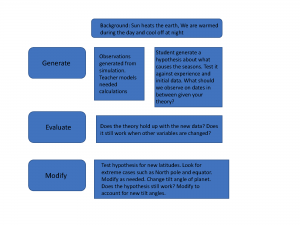This week, I had the opportunity to investigate Winn (2003), Aleahmad and Slotta, J. (2002), and Núñez (2012).
Winn (2003) provides a robust reimagining of the constructivist framework in light of developments in neuroscience. Winn (2003) situates embodied learning as an outgrowth of both constructivist and information processing theories. Winn (2003) rejects the constructivist perspective that a learner’s constructions are to unique to be adequately measured. He asserts that, instead, an educational designer can make use of artificial environments add predictability to the constructions students might make. With regards to information processing, Winn (2003) views the previous views as inadequate due to an exaggerated focus on symbol manipulation and insufficient exploration of their meaning. Winn expresses theory central tenants to the theory: That cognition is linked to our physical being (embodiment), that we are coupled to our environment (embeddedness), and that we influence, and are influenced by our environment (adaptation).
Nunez (2012) examines the state of embodied cognition as a theory. Nunez identifies that embodied cognition is capable of providing rich descriptions of phenomena but that many other theories have stalled at this point. To be considered scientific, embodied cognition must begin to generate testable theories. If it is unable to provide these, embodied cognition may not have a sufficient claim be being considered scientific.
Aleahmad and Slotta (2002) looked at the use of handheld devices for data collection when combine with the wise environment. They found promising results from two trials and were able to implement both survey style and measurement style data types.
Aleahmad and Slotta (2002) seem to have happened upon a possible solution to issues faced in Winn (2003). Winn asserts that engagement with artificial environments is key to realizing their benefits. What the tablet devices may allow is a sort of bridge between the artificial and real environments. When students leave the classroom, they must uncouple from an artificial environment. The tablet might serve as a kind of tether. The presence of the device, and the fact that data collect with it will return to the artificial environment, serves to continually remind students of the presence of the artificial environment waiting for them back in the classroom. Despite not being present, the artificial environment still acts upon the cognition of the student and influences how they behave in the real environment. These actions, in turn, will alter the artificial environment through the input of new data. In essence, while Winn (2003) was looking for a solution to students becoming distracted from the desired artificial environment, Aleahmad and Slotta (2002) are using a tablet to, in a way, distract students from the real environment and back to the artificial one.
In my own practice, I have had some great success using WISE to investigate the cause of the seasons. Instead of data gathering with mobile devices though, I used simulations with my students. The process clearly reflected Winn’s (2003) view that both the student and the artificial environment mutually influence each other. The students began with data to collect. As they manipulated the simulations, they began to develop questions. This led to different tests of the environment yielded further result and more questions. I also found that the use of simulations seems to reduce cognitive load. Students were able to reason more accurately when observing a model/simulation instead of having to use their working memory to represent and manipulate representations of the earth and sun.
Going forward, I would certainly plan to use more simulations to help students discover phenomena, scaffolded by leading questions or key data that needs to be gathered. Timely provision of dissenting information and observations, a key tool I began using in the above WISE unit, will be carried forward into other STEM subjects to help facilitate inquiry learning.
In terms of some questions about embodied learning, I wonder, to what extent could practicing externalized cognition can impact student learning in STEM disciplines? By prescribing certain styles or approaches to of note taking, equation solving, unit analysis, etc., in the external environment, might we be able to shape a student’s conceptions more accurately?
References:
Aleahmad, T. & Slotta, J. (2002). Integrating handheld Technology and web-based science activities: New educational opportunities. Paper presented at ED-MEDIA 2002 World Conference on Educational Multimedia, Hypermedia & Telecommunications. Proceedings (14th, Denver, Colorado, June 24-29, 2002); see IR 021 687. Available at: https://eric.ed.gov/?q=Integrating+handheld+Technology+and+web-based+science+activities%3a+New+educational+opportunities&id=ED476962
Núñez, R. (2012). On the science of embodied cognition in the 2010s: Research questions, appropriate reductionism, and testable explanations. Journal of the Learning Sciences, 21(2), 324-336. http://ezproxy.library.ubc.ca/login?url=http://dx.doi.org/10.1080/10508406.2011.614325
Winn, W. (2003). Learning in artificial environments: Embodiment, embeddedness, and dynamic adaptation. Technology, Instruction, Cognition and Learning, 1(1), 87-114. Full-text document retrieved on March, 2017, from: http://www.hitl.washington.edu/people/tfurness/courses/inde543/READINGS-03/WINN/winnpaper2.pdf
